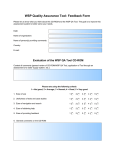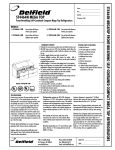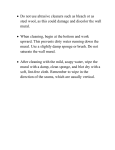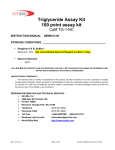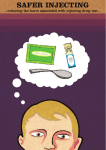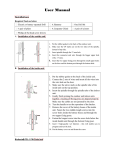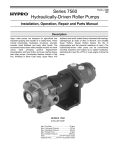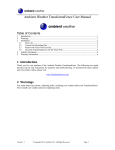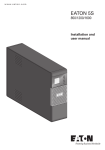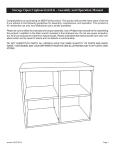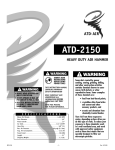Download Hoefer PR648
Transcript
user manual blotting Hoefer PR648 Slot blot manifold um PR648-IM/Rev.F0/08-12 Page finder Introduction...........................................................1 Specifications........................................................2 Procedure for standard use of the Hoefer PR648 .................................................3 Setting up the Hoefer PR648 .............................3 Applying your samples........................................5 Removing your blot.............................................5 Care and maintenance............................................6 Troubleshooting......................................................7 Ordering information...............................................8 • pi Introduction Slot-and dot-blotting techniques have been used extensively in molecular biology to immobilize nucleic acids and proteins on membranes for determining nucleic acid homologies, quantifying mRNA, studying hormone receptor binding, detecting protein-nucleic acid interactions, and screening for specific proteins by activity or antibody. The slot-shaped blots produced by the Hoefer® PR648 slot blot filtration manifold are more reliably and accurately quantitated by scanning densitometry than dot blots. For a series of dots, the scan path must pass directly through the center of all the dots. Slots are not so demanding in alignment and allow much wider representative scan paths. The Hoefer PR648 slot blot filtration manifold is designed and manufactured to provide an efficient seal around each slot insuring a consistent shape and size. As little as 50 µl of sample applied to a membrane through the slot will yield a clearly defined band with evenly distributed sample. Each Hoefer PR648 slot blot is comprised of three separate blocks. The upper block has 48 labeled slots for samples, arranged in a 4 × 12 array. The blotting membrane is placed in a recess on the top of the middle (membrane support) block. The bottom block has a connector for the vacuum source. To assemble the Hoefer PR648 slot blot, simply place the membrane in the membrane support block recess, stack the blocks together, and insert and tighten the screws. Attach the connector on the bottom block to a vacuum source and apply your samples in the slots. • p1 Specifications Number of slots: 48 Slot dimensions: 6 mm × 0.80 mm Slot spacing: 9.0 mm × 18 mm (from center to center) Slot membrane surface area: 4.8 mm2 Maximum well volume: 1 ml Recess dimension: 82 mm × 115 mm Unit dimensions: 12 cm × 15.5 cm × 8 cm Fig 1. The Hoefer PR648 slot blot set up for standard use. top block membrane membrane recess membrane support block orientation corner quick disconnect bottom block • p2 Procedure for standard use of the Hoefer PR648 The following procedure produces a well-defined blot with sharp edges with many types of samples. To determine the optimal load per slot for the particular membrane and samples you are using, we suggest first blotting a set of serial dilutions. Setting up the Hoefer PR648 1 Place the bottom block on the lab bench. Place the membrane support block (middle block), with the 0-ring facing down, on top of the bottom block. The membrane recess in the membrane support block has one curved corner. Orient the block with this corner on the lower right (see Fig 1). 2 Wear gloves to avoid leaving fingerprints on the membrane. Place the membrane cutting template, ridge side down, on the membrane. Exert slight pressure on the template to leave a mark on the membrane. Cut the membrane along the mark. The template has been sized to allow for swelling of all types of membrane. 3 Soak the membrane in appropriate buffer for a few minutes to wet it thoroughly. (A dry membrane will draw sample under the sealing ridge and away from the slot, resulting in a poorly defined slot image on the membrane.) 4 Place the membrane completely within the recess, aligning the clipped corner of the membrane with the clipped corner of the recess. Make sure the membrane is flat and fits completely within the area, with edges parallel to the recess edges. If the membrane is not positioned correctly, lift it up and reposition it. • p3 5 Carefully set the top block, with letters and numbers facing up, on top of the membrane support block. 6 Note: Do not over-tighten. Over-tightening causes leaks. Insert the screw into the threaded holes. Tighten the screws until the knobs just touch the surface of the block. 7 Hand-tighten each screw only a small amount, following the sequence shown in Fig 2. Repeat the sequence one or two times until all screws are snug. 8 Fig 2. Correct order for tightening the screws. Attach the slot blot to a small vacuum pump with adjustable vacuum and a vacuum gauge. If an adjustable vacuum pump is not available, use a water aspirator or a house vacuum and place a bleed valve and vacuum gauge in the vacuum line. 9 To keep liquids from being sucked into the vacuum source, set up a liquid trap between the slot blot and the vacuum source as shown in Fig 3: a. U se a side arm vacuum flask and a stopper with a small hole. b. Insert a glass tube through the stopper hole. Position the tube so that it extends below the flask sidearm when the stopper is in place. c. S topper the flask. Use a length of rubber tubing to connect the glass tube in the stopper to the connector on the Hoefer PR648. Fig 3. Correct set-up of the liquid trap. • p4 d. U se a second length of tubing to connect the sidearm of the flask to the intake port of the vacuum pump or to the vacuum line. Applying your samples 1 Turn on the vacuum pump and adjust the pump or bleed valve until the vacuum is 13 – 25 cm Hg. 2 Turn off the vacuum. 3 Note: Do not use samples containing organic solvents. Carefully load a sample, at least 50 µl in volume, into each well. (A 50 µl size is necessary to distribute the sample evenly over the slot.) To prevent bubbles from forming, pipet each sample against the bottom side-wall of the well. This is especially important it your sample contains proteins or detergents. If bubbles should form, flush them out with the pipetter tip. 4 Turn on the vacuum and set it at 13 – 25 cm Hg. When all of the sample liquid has been pulled through the membrane, add 1 ml of buffer to each slot, pipetting against the bottom-side wall. Adjust vacuum to 38 – 50 cm Hg. After all of the buffer is pulled through, repeat twice more for a total of three rinses. Removing your blot 1 With the vacuum still on, remove the screws and carefully lift off the top block. 2 Using forceps, lift the membrane off and place it on clean, dry filter paper. Turn off the vacuum. 3 Process the membrane according to your protocol. 4 If you plan to scan the blot itself with a densitometer, dry the membrane flat by placing it on the smooth side of a porous polyethulene sheet. Dry it for several minutes in a vacuum gel dryer without heat. • p5 Care and maintenance 1 If the slot blot is used with radioactive materials, decontaminate the 0-ring between uses. You may wish to purchase a second ring for non-radioactive work. (See Ordering information.) 2 Wash all blocks thoroughly in a mild water-based laboratory detergent, then rinse well in distilled water. Brief exposure to 5% bleach solutions can be used. Do not use ethanol or other organic solvents. Do not autoclave the slot blot or wash it at high temperatures. 3 Blot all blots dry immediately. Acrylic can absorb water, which may cause it to warp. 4 Store the slot blot away from direct sunlight. If you store it assembled, do not tighten the screws. 5 Store the PR648 slot blot with the membrane cutting template, flat side-up, between the middle and top blocks. This will protect the sealing ridge surrounding the slots. • p6 Troubleshooting problem solution If the sample area on the membrane is larger than the slot size, or if the solution is leaking out of the slot… Screws are tightened too far or not tightened far enough. Carefully follow the tightening instructions in Steps 6 and 7 in Setting up the Hoefer PR648 slot blot. The membrane is not positioned correctly with the recess. Make sure the membrane is flat and fits completely within the recess with its edges parallel to the recess edges. The membrane is dry. efore blotting, be sure to soak the membrane in buffer to B wet it thoroughly. If small impressions show on the membrane around the blot… This is normal. The impressions, which indicate a tight seal, will not affect your results if you scan the membrane in reflectance mode. Place the membrane flat on the smooth side of a porous polyethylene sheet, and dry it for several minutes in a gel dryer without heat. If there are bubbles in the slot… There are proteins or detergent in the sample. Or, the sample was squirted rapidly into the slot. To prevent bubbles from forming, be sure to pipet the sample slowly and carefully against the bottom side-wall of the slot. If necessary, flush bubbles out with a pipette tip. • p7 Ordering information product qty. code no. Basic Unit Hoefer PR648 Slot blot manifold with Quick Fit connector and membrane cutting template. 1 PR648 Top Block 1 PR654 Membrane support block (middle block). Includes O-ring. 1 PR659 Bottom Block 1 PR656 O-rings 1 PR657 Screws 6 PR658 Membrane cutting template 1 PR659 Replacement Parts for the PR648 Slot blot • p8 Hoefer, Inc. 84 October Hill Road Holliston, MA 01746 Toll Free: 1-800-227-4750 Phone: 1-508-893-8999 Fax: 1-508-893-0176 E-mail: [email protected] Web: www.hoeferinc.com Hoefer is a registered trademark of Hoefer, Inc. © 2012 Hoefer, Inc. — All rights reserved. Printed in the USA. • p9











